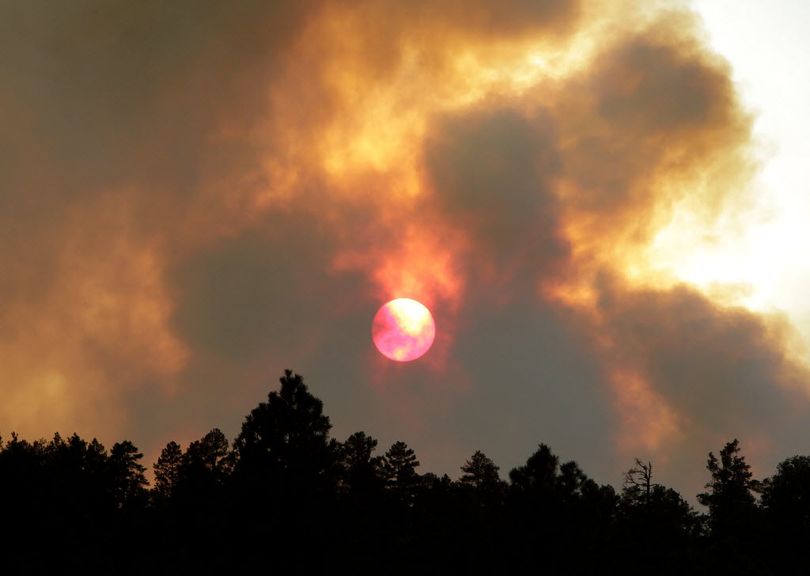84 percent of wildfires caused by humans, study finds

WILDFIRES -- A study analyzing wildfire records from 1992-2012 has found that humans started 84 percent of all wildfires nationwide. In northwestern states — including Idaho, Washington, Oregon, and Montana — humans started about half of all wildfires, says University of Idaho researcher John Abatzoglou.
"Not all fire is bad," Abatzoglou says in a University media release. "But humans are intentionally and unintentionally adding ignitions to the landscape in areas and seasons when natural ignitions are sparse. We can’t easily control how dry fuels get, or lightning — but we do have some control over human-started ignitions.”
Abatzoglou, an associate professor of geography in the UI College of Science, worked with project leaders Bethany Bradley of the University of Massachusetts Amherst and Jennifer Balch of the University of Colorado-Boulder on the analysis, published today in the Proceedings of the National Academy of Science.
Here's more from the university regarding this and related research:
Northwest Fires by the Numbers
The researchers found that of the 1.5 million fires that required fire fighting from 1992-2012, 84 percent were started by humans, accounting for almost half, 44 percent, of area burned nationwide.
But in Idaho — which had the largest burned area of any state in the lower 48 from 1992-2012 — only 31 percent of fires were human-caused, accounting for 17 percent of the total burned area. Humans were responsible for starting 48, 53, and 70 percent of all fires in Oregon, Montana, and Washington, respectively, accounting for 15, 18, and 46 percent of the total burned area from 1992-2012.
The Pacific Northwest’s lower numbers are due in part to population density: Especially in Idaho, there are millions of acres of uninhabited or sparsely populated land.
“The fire season across much of the Northwest is largely a function of the convergence of the seasonal drying of vegetation throughout the summer with warm temperatures with occasional dry thunderstorms during the months of July and August,” Abatzoglou said.
While lightning is responsible for the majority of burned area in the Pacific Northwest, the dry conditions that typically set in during the summer months also encourage outdoor activities that introduce human ignitions to a flammable landscape.
How Humans Expand Fire
The researchers conclude that humans are expanding the “fire niche,” bringing fire to locations and environmental conditions where lightning does not start fires naturally, said Bradley, an associate professor of spatial ecology and biogeography at the University of Massachusetts Amherst. For example, November 2016’s unseasonal and devastating wildfires in Tennessee were likely human-caused.
“We saw significant increases in the numbers of large, human-started fires over time, especially in the spring,” Bradley said. “I think that’s interesting, and scary, because it suggests that as spring seasons get warmer and earlier due to climate change, human ignitions are putting us at increasing risk of some of the largest, most damaging wildfires.”
The researchers included arson, smoking, railroads, fireworks, and children playing with fire, as well as campfires and burning debris, among the ways humans start wildfires. Vehicles also spark fires along roadways, Abatzoglou said, and downed power lines can start fires in remote areas.
“The hopeful news here is that we could, in theory, reduce human-started wildfires in the medium term,” said Balch, director of CU Boulder’s Earth Lab. “But at the same time, we also need to focus on living more sustainably with fire by shifting the human contribution to ignitions to more controlled, well-managed burns.”
Abatzoglou’s previous research also emphasizes an additional way humans increase wildfires: climate change. In October, Abatzoglou and a Columbia University researcher published a study showing that human-caused climate change has nearly doubled the amount of land burned in western U.S. forest fires over the last three decades.
About the Research
To reach their conclusions about human-started fires, the researchers used the publicly available U.S. Forest Service’s Fire Program Analysis-Fire-Occurrence Database, which includes federal, state and local wildfire records on public and private lands from 1992-2012. They did not include prescribed burns or agricultural fires.
To assess 20-year trends in human- vs. lightning-caused wildfires, they used only large fires that were independently verified by a multi-agency project providing consistent burn severity data and fire perimeter information to researchers and relevant agencies.
The research was funded by the National Aeronautics and Space Administration Terrestrial Ecology Program, the Joint Fire Sciences Program and Earth Lab through the University of Colorado-Boulder’s Grand Challenge Initiative.
